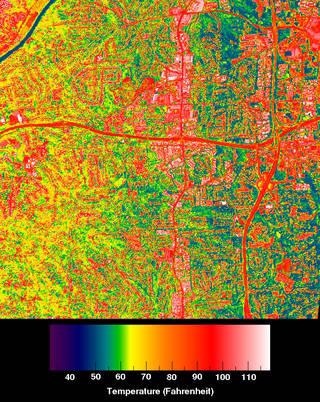According to climate experts at NASA’s Goddard Institute for Space Studies (GISS) in New York, rooftop gardens and vegetation can help alleviate some of the city’s extreme heat. Researchers have advocated for the replacement of black tar as well as other dark-colored roofing systems with bright, Sun-reflecting surfaces or “green roofs” with plant cover for decades.
 The satellite imagery of suburban Atlanta, captured by Landsat 5 in an older study, shows the differences in daytime heating, as caused by the urban heat island effect. Image Credits: NASA’s Scientific Visualization Studio / Greg Shirah.
The satellite imagery of suburban Atlanta, captured by Landsat 5 in an older study, shows the differences in daytime heating, as caused by the urban heat island effect. Image Credits: NASA’s Scientific Visualization Studio / Greg Shirah.
Scientists have now utilized open-source satellite data to assess the effectiveness of these improvements.
The urban heat island effect is a phenomenon in which heat is enhanced or amplified in cities. As asphalt, concrete and other similar surfaces absorb and hold more heat than vegetation, temperatures in metropolitan areas are frequently 10 °F higher than those in neighboring suburbs or rural areas.
This heat disproportionately affects elderly people, low-income populations and some communities of color in neighborhoods with fewer trees and green spaces.
Green roofs are used to reduce the temperature in urban areas by utilizing the cooling effect of plants. Greenery can be widespread (shallow soil, low-maintenance plants) or intense (high-maintenance plants) (deeper soil, more diverse plants, and trees).
The GISS team looked at three locations in Chicago to investigate how green roofs influenced surface temperatures surrounding the buildings, as well as whether there was a variation between those locations and others nearby that did not have green roofs. The efficiency of two of the three green roofs in the research was shown to be dependent on location and plant diversity, among other criteria. The findings were recently published in the journal Sustainable Cities and Society.
Studying green roofs in urban jungles
As cities grow and develop, they need to make good decisions about their infrastructure, because these decisions often last for 30 or 50 years or longer. In the context of more frequent heatwaves and more extreme heat, it’s important to understand how these urban design interventions can be effective.
Christian Braneon, Climate Scientist and Civil Engineer, Goddard Institute for Space Studies
In the early 2000s, Braneon and the GISS team collaborated with Chicago’s Public Health and Planning and Development departments to investigate three green roof installations: Millennium Park, City Hall and a Walmart retail mall. The researchers evaluated changes in land surface temperatures and plant density at the study locations with neighboring control sites without green roofs using photos taken by the Landsat 5 satellite between 1990 and 2011.
The findings from the three locations were mixed. After its green roof was erected in 2004, Millennium Park, which has a dense mix of vegetation and is located near Lake Michigan, exhibited much lower average temperatures. Over the research period, it was the only location where the roof completely prevented climate warming.
In 2002, a green roof was built on City Hall, which is also a high-traffic area. Its temperatures were lower after the green roof was installed than at the control site, although they began to rise as the research period came to an end.
The Walmart site, on the other hand, told a different narrative. The supermarket was erected during the study period, whereas the green roofs at Millennium Park and City Hall were placed alongside structures. Even though Walmart has a large green roof, the transformation of the property from an empty, grassy lot to a shop has resulted in a drop in the landscape’s vegetation index.
Braneon, who co-leads GISS’s Climate Impacts Group’s urban research added, “In a lot of places, you might be developing an area that didn’t have something there before; it just had overgrown vegetation.”
You might think that putting a green roof on your new building would make a significant impact. But what we see is that a lot of impervious material may also be added there—such as a parking lot around the building. As a result, you might reduce the impact of the parking lot, but you certainly haven’t created the cooling effect that the overgrown vegetation had.
Christian Braneon, Climate Scientist and Civil Engineer, Goddard Institute for Space Studies
The advantages of green roofs are dependent on a range of elements, according to the experts, ranging from geographic location and plant diversity to rooftop design and the building’s cooling efficiency.
To peel apart these nuances, greater sample numbers are needed, but this research provides a promising start. With urban heat island impacts predicted to worsen as the world’s temperature rises, it is more crucial than ever to understand these variables.
According to main author Kathryn McConnell, a doctorate candidate at Yale University’s School of the Environment, the study approach is meant to be employed by other cities for additional research. The easy analysis, publicly available data and approach for working directly with cities should assist city planners in determining the viability of green roofs in their areas.
My hope would be that the methods we proposed show a low-cost way for folks working in less-resourced cities—who maybe don’t have access to a university or government researcher—to study their own communities.
Kathryn McConnell, Study Lead Author and Doctoral Candidate, Yale University School of the Environment.
“Traditionally, civil engineers and urban planners assumed a stationary climate,” Braneon added. “The whole practice is built on the premise that we can look at the past to assess risk in the future. Everything is being flipped on its head due to climate change, so I’m hoping to do more work that changes how civil engineers and urban planners practice.” McConnell concluded.
Journal Reference:
McConnell, K., et al. (2022) A quasi-experimental approach for evaluating the heat mitigation effects of green roofs in Chicago, Illinois. Sustainable Cities and Society. doi.org/10.1016/j.scs.2021.103376.
Source: https://www.nasa.gov/